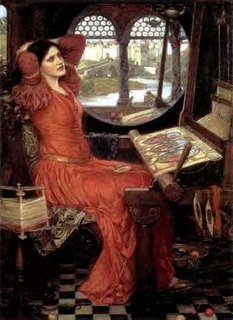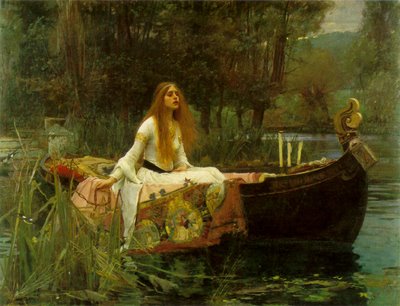Watched: Antony & Cleopatra live by the RSC at the Swan, with Patrick Stewart and Harriet Walter. Breathtaking!
Listened to: Schubert's String Quintet in C Major, D. 956
Here’s an ekphrastic poem to follow the post on Turner & the Tate.
Comments & Critique are welcome. Enjoy!


Shadow
On John William Waterhouse’s “Lady of Shalott” paintings
She stands in staring fantasy and wrings her hands,
knotting and weaving colored noises in silence.
Twisted threads paint scenes in her mind
where she warps their lost nights in tight tapestry.
A binding chill dims her half-sick sight
in spite of summer windows, noonday walls.
Lovely devourer, locked in the solitude
of her hollow desire. Bruises darken somewhere
inside her luminous skin, where she clings
to sweet self-forged chains and refuses
the searching thought of outdoor light. Lonely,
fingers caught in her loom, she gazes inward.
Three streaks of candlelight draw her down
into dreaming, seeing him imprisoned there,
while she sits spinning albas and elegies in red
through black-warped daydreams on her loom.
No farewell for these memories, these three
conjured nights deep in her lurid fantasy.
The tapered flames double again and again
in her stare, a bronze mirror, the lake…
a breastplate, shield, and sword.
Dull as standing water, drifting into night,
the tall flames swim in her shrouded sight
like flashing lances raised by brave knights
as they die, like her strands of hair bound
by golden bands, like her pale arms hung
with heavy cloth. She sees and does not see,
wishing scenes in waking sleep.
...
At last in her self-wrought dream,
tapestries complete, she piled weavings into the prow,
stood straight among reeds, followed along the river,
still longing. When the candles reflected
off turrets, battlements, silver towers,
and armor, she closed her eyes.
~ Admonit

5 comments:
I am just realizing that there is something about reading poetry on the screen that makes it difficult to absorb and comment on. I think I might have to print this out and see it all on one page in order to do that. Even when printed poetry spans more than one page, it seems more natural to read and understand than scrolling up and down on a computer screen. It might be just that I was brought up in the print generation. Or perhaps it's that I'm still relatively new at reading and appreciating poetry, so I need to sit with it for a longer time. Not something that reading online is conducive to doing.
Rosie, I agree about poetry on the computer screen. I have to print it out. I think it's mostly because you and I were trained in print/on paper. The computer does lend itself to faster reading, but I think that's also a feature of a generation trained on the screen. Not sure which one came first: reading on the screen, or speed-reading-skimming.
Brittany,
which prints do you have? Aren't they lovely? We were given a beautiful paint-on-canvas print of Windflower as a wedding gift. I hope someday to hang Psyche entering Cupid's Garden next to it, as that's probably my favorite, and a work of art I've sort of taken as my aesthetic manifesto.
I had the joy of reading this poem last night at a "Deep Hall Reading" in our very own Lincoln College pub. Reading it aloud is always a telling (or showing? or revealing?) experience. It sounded kind of boring to me, as if it doesn't go anywhere. It's static. So an insightful friend of mine located the moment of difficulty for me. (This friend's Teresa; take a look at her blog http://cafecobblestone.blogspot.com. She write a lot of lively tales of what we're doing here in Ox, and has lovley photos.)
Here's the moment in the poem at which something needs to happen, and doesn't:
She sees and does not see,
wishing scenes in waking sleep.
...
At last in her self-wrought dream,
etc. Where I've put in elipses, there needs to a the turn, a change, the denoument. I need to ponder and clarify my thoughts. Any ideas? Suggestions are more than welcome.
- Sorina
Read: The Last Dance: Facing Alzheimer's with Love & Laughter by Ann McLane Kuster. Lovely!
Listened to: Beethoven's late String Quartets, Nos. 12, 13, 16, and "Grosse Fugue"
Yes, I agree that the computer facilitates faster reading, even encourages it, but that's exactly what you don't want when reading a poem. That, I think, is why I need to see it in print. So that I can read it slowly.
I agree that the poem is somewhat static, but I'm not sure what to suggest to fix that. I'm not sure "static" is always bad in a poem (many of Luci Shaw's poems are delightful without having any dramatic twist in them). Your poem does hint at something beyond the painting, which an ecphrastic poem has got to do, I think. Otherwise what's the point? But I'm not sure it does anything more than return us to the literary origins of the paintings, rather than creating an imagined background for them, as ecphrastic poetry often does. I looked further into the paintings (something else facilitated by the computer!). This is an interesting case of multiple layers of literary/artistic allusion. Your poem is based on the Waterhouse paintings, which in turn are based on the romantic poem "The Lady of Shalott" by Alfred, Lord Tennyson, which in turn is "commonly believed to have been loosely based upon a story from Thomas Malory's Le Morte d'Arthur concerning Elaine of Astolat, a maiden who falls in love with Lancelot, but dies of grief when he cannot return her love. However, Tennyson himself said that the poem was based on a thirteenth-century Italian novelette entitled Donna di Scalotta, which focuses on the lady's death and her reception at Camelot..." (according to Wikipedia).
Perhaps the solution is to dig further into those literary roots of the paintings, and find an obscure element of the story you can expand upon, or something you can fictionalize to make your poem more dynamic. I'm not sure if that is fair game in ecphrastic poetry, or whether it is supposed to stick to elaborating on the picture itself. I'm reading a book on ecphrastic poetry right now called The Gazer's Spirit: Poems Speaking to Silent Works of Art, by John Hollander. I haven't read enough to come upon anything approaching "rules" for how to write ecphrastic poetry. I've tried my hand at one recently, which I'm not ready to post here yet, because I've submitted it for workshopping in a class with Scott Cairns at the Glen Workshop. I'll post it here after I've improved it with feedback from Scott and my classmates.
Thanks very much, Rosie. Yeah, I have in mind some "obscure elements" of the original stories, but they're not coming through clearly. I'm going to work on that "turn." You said, "I'm not sure if that is fair game in ecphrastic poetry, or whether it is supposed to stick to elaborating on the picture itself." It is totally "supposed" to go a far afield as it likes; whatever the work of art makes the poet think of, imaginary backstory, associations, whatever. I'd love to hear more about the book you're reading, and of course to see your poem when you're ready to share it.
Post a Comment